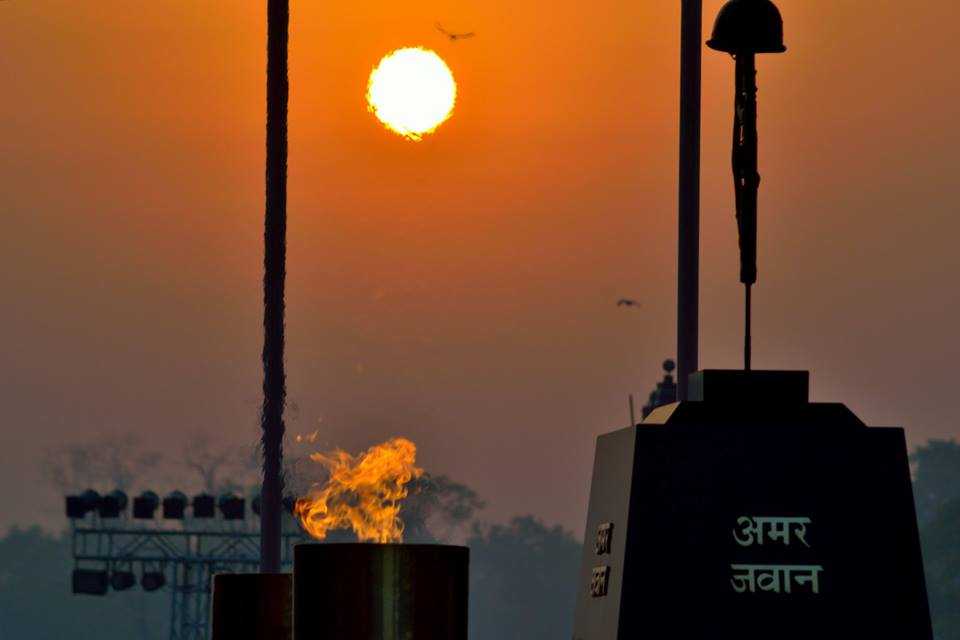The India Gate or 'All India War Memorial' is one of the most iconic national monuments of India and stands high in the national capital of Delhi. Situated on Rajpath, the monument was built in the memory of 90,000 soldiers who lost their lives during the First World War and the Third Anglo-Afghan War. 42 meters high, constructed with pale stone, red stone and granite; India Gate is inspired by 'Arc De Triomphe' in Paris and was designed by the British architect Sir Edwin Lutyens. The flags of Indian Army, Indian Navy, and Indian Air force are put behind the India Gate to represent the power of Indian Military.
What is Amar Jawan Jyoti?

Prime Minister Indira Gandhi fist paid homage to the Indian soldiers at India Gate on the eve of 23rd Republic Day on 26 January 1972. Since then, the Prime Minister of India pays tribute to the soldiers at this site along with the heads of Indian Armed Forces, before becoming the part of the annual parade held at Rajpath on each Republic Day.

Surrounded by sprawling lush green gardens, India Gate is one of the most popular tourist destinations in India. It is almost symbolic of Delhi, and it is imperative for tourists to visit this legendary structure while they are in the city. The evenings at India Gate are always bustling with activity, with lots of people taking leisurely walks in the gardens and enjoying the roadside eateries.

Structure of Amar Jawan Jyoti
Amar Jawan Jyoti, or the flame of the immortal soldier, is a structure made of a black marble plinth. The structure is a reversed L1A1 Self-loading rifle, capped by war helmet, bound by four urns, each with the permanent light called Jyoti, from flames fueled by CNG. The structure was erected under the India Gate in the wake of the Liberation of Bangladesh in December 1971. It is a structure erected to commemorate the Indian soldiers killed in the defence of the country. Amar Jawan Jyothi serves as a tomb for the unknown soldiers. Amar Jawan Jyoti is manned round the clock by soldiers drawn from the three services of the Indian armed forces.Amar Jawan Jyoti Location
India Gate is situated at about a mile from Connaught Place, at the eastern end of Rajpath in Central Delhi.
How to Reach Amar Jawan Jyoti
The nearest Metro Station is the Central Secretariat Metro Station, which falls on the Yellow Line.Timings & Best Time To Visit
India Gate is open throughout the year, all days and round the clock. It takes about an hour to explore the entire premises. Best time to visit the monument in summers is 7:00 PM - 9:30 PM, as the days in Delhi can be quite hot. However, in winters any time is suitable.
Nearby Attractions
Located in Central Delhi, India Gate is surrounded by various other important structures. Some of them are listed below.
Rashtrapati Bhawan- The majestic structure serves as the official residence of the Indian President.
North and South Block- A high profile area where all the major government offices are located.
Parliament House- The colossal building serves as the office for Indian Parliament. The important decisions of world's largest democracy are carried out at this structure.
National Museum- The national museum displays an elaborate collection of various Indian and international artefacts that hold historical significance.
National Gallery of Modern Art- The museum is famous for its exhibits of contemporary Indian art. More than 4,000 paintings, graphics, and sculptures created by modern artists are displayed here.
Connaught Place- The most known market in Delhi, the Connaught place is a heritage market designed in British style where one can find anything like clothes, food, jewellery, books, leather goods, etc.
Central Cottage Industries Emporium- People can buy traditional Indian clothes here which come from all corners of India.
Baba Kharak Singh Marg- Created by accomplished artisans, the exclusive art, and craft of each Indian state is rendered in the market at Baba Kharak Singh Marg.

Tall, beautiful and majestic, the India Gate stands proudly in the middle of Delhi harbouring the ever-burning Amar Jawan Jyoti. A symbolic of Delhi, the premises of India Gate is flocked with tourists throughout the year, be it for inspiration, leisurely walks or picnics.
